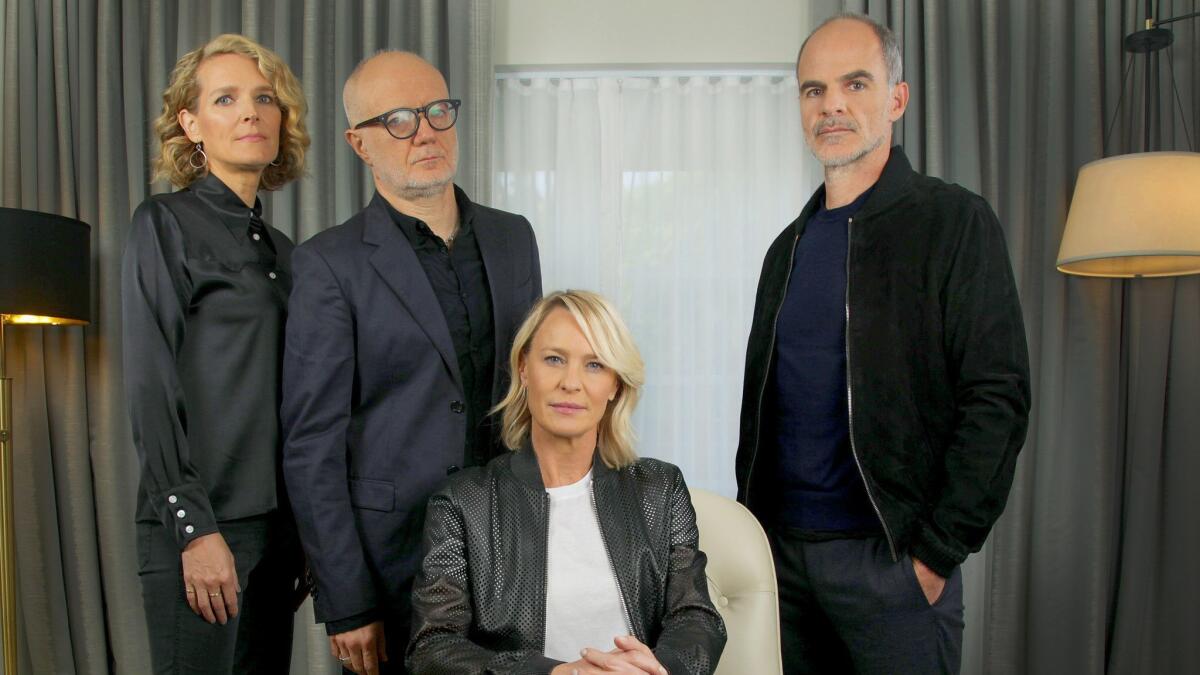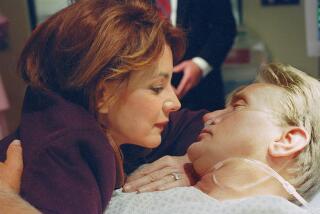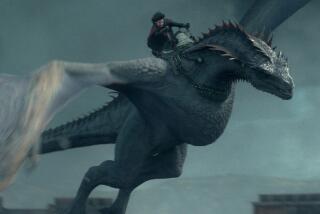Here’s what the cast and producers of ‘House of Cards’ had to say about writing off Kevin Spacey’s character — and that final scene

(Warning: This article contains spoilers from the final season of “House of Cards,” which was released Friday on Netflix.)
Days before the high-stakes drama of next week’s midterm elections unfolds, Netflix has unloaded the sixth and final season of its not-quite-stranger-than-fiction political opera “House of Cards.”
Friday’s end brings to a close Netflix’s flagship original series, which helped set in motion the company’s dominance in Hollywood and upended traditional television. But reaching the finish line also came with a major hurdle: wrapping the series without its formidable lead character, Frank Underwood, who was played by Kevin Spacey before he was fired after a number of sexual misconduct allegations surfaced last year.
‘House of Cards’ finishes its run far from where it started »
Season 5 ended with the show’s ruthless protagonist, facing impeachment for crimes he committed while in office, resigning as president — a scheme he concocted so that his wife and vice president, Claire Underwood (Robin Wright), could pardon him upon her ascension to the highest office. Except she didn’t.
The new season, which aims to be an exploration of who owns the White House, opens with Claire, now a widow, roughly 100 days into her presidency. She’s unafraid to stand in her power, but also struggling to break free from Frank’s looming presence. Until the end, depending on how you look at it.
We spoke to showrunners Melissa James Gibson and Frank Pugliese, as well as Wright and Michael Kelly, who has played Frank’s eternally loyal right-hand man since the beginning, about the death of Frank and that final scene of the series.
Frank Underwood’s death
Frank’s death is addressed in the opening minutes of the first episode of the final season. Sitting behind her desk in the Oval Office, Claire is listening as a staff member reads a string of harsh statements and threats toward her from the American public — the criticisms have increased significantly, viewers learn, since Frank’s death.
“We didn’t want it to be the elephant in the room,” James Gibson said. Of course, the story behind the cause of Frank’s death shifts as the final eight episodes play out.
“We wanted to face it,” James Gibson added, “but then it felt, because of the void left and all the various investments and agendas with the rest of the characters, there were different versions of the truth and it felt right for there to be a battle for that narrative.”
The story told to the American public is that Frank died beside Claire while they were sleeping, but viewers know the estranged couple were not sharing a bed. So what’s the real story? After all, as Claire states early in the season, “a man like Francis doesn’t just die.” Claire suspects he was murdered after aligning himself with a pair of wealthy corporate power brokers. She tells viewers the last time she spoke with Frank was the night she declined his call about the pardon. She says he showed up at the White House in a rage and she locked herself in her room. When she woke up the next morning, she found him dead in his bed. “They killed him to shut me up,” she says directly to the camera.
When I first heard it, I was, like, ‘Wait, what?’
— Michael Kelly, who plays Doug Stamper on ‘House of Cards,’ on Frank Underwood’s death
The truth ultimately is revealed in the final moments of the season: Doug Stamper, Frank’s eternally loyal right-hand man played by Kelly, admits to a now-pregnant Claire that he’s responsible for the death. According to Doug, on that fateful night, Frank was going to the White House to kill Claire.
Driven to protect Frank’s legacy, Doug killed him. He used Frank’s medication as the weapon: “I didn’t know how long it would take … but I knew.”
The development took Kelly by surprise, he admits.
“When I first heard it, I was, like, ‘Wait, what?’” he recalled. “But I loved it. When it was explained to me, I fully understood. It was a mercy killing. He was saving Frank’s life by killing him.”
Wright added: “It says so much about him and about what he’s willing to do to protect this man’s legacy. And what Claire wasn’t willing to do.”
That final scene
In case it wasn’t already clear, an undercurrent of the season is the sordid dynamic of the Frank-Claire-Doug triangle. Doug is aggrieved that Claire is not mournful over the death of Frank and is not facing consequences for her part as Frank’s co-conspirator in their game for power. Claire, meanwhile, wants to break free from Frank’s shadow but can’t manage as long as Doug is around.
In his absence, Frank’s two greatest intimates are in battle until the bitter end. The final scene is essentially a showdown between Doug and Claire in the Oval Office. After confessing that he killed Frank, Doug grows agitated by Claire’s refusal to give Frank credit for her rise. He takes a letter opener (significant because a letter opener was the last thing Frank gave Doug from his desk) and pins it against Claire’s neck.
But he hesitates. Claire, in the end, jams it into Doug’s torso, setting his death in motion. She places her hand over his mouth and, mirroring the opening moments of the first episode in Season 1, declares: “There, no more pain,” before looking straight at the camera.
“I think it’s so symbiotic,” James Gibson said. “It’s almost like they are building toward the ending together as characters. They’re negotiating it and becoming complicit with each other.”
Added Pugiliese: “I think we are gonna diminish it by trying to explain too much of it. It’s actually something the audience has to go through.”
“Yeah,” James Gibson continued, “because who wins in the end is up for debate, really. Who knows what happens the day after.”
“Beautifully macabre” is how Wright described the final moments.
“Doug doesn’t have anything else,” she said. “He annihilated the very thing that pumps his heart, that fuels the blood in his vessels.”
“Killing Frank takes Doug off life support,” Kelly echoed. “From that moment on, it’s, like, ‘Oh, crap, now what?’ And as he goes to kill Claire, there’s the realization of, ‘I can’t kill her. I can’t kill Frank’s legacy — the baby.’ ”
I think we are gonna diminish it by trying to explain too much of it. It’s actually something the audience has to go through.
— Frank Pugliese, co-showrunner of ‘House of Cards,’ on the series’ closing scene
Wright, who directed the finale, said the show ended slightly differently in the director’s cut. In that version, the camera panned up at the end of that scene and included a voiceover of Claire talking to the audience.
“It was so great,” Wright said. “The camera just pans all the way up, and you see the White House, and them laying in a pool of blood together. And the voiceover is in essence saying, ‘We all have watched this. We’ve all been privy to it. Doesn’t it make you think?’ Basically asking the audience to consider their culpability. And that’s so prevalent today on all fronts.”
Asked why the series, instead, ends with Claire looking directly into the camera, Pugiliese said: “It was the acting. With that look, she said everything we might have wanted to say with words.”
Voiceover or not, the producers hope viewers view it as a satisfying and organic ending to the series.
“We we’re trying to be courageous,” he continued, “and also come to an ending that in retrospect was inevitable. That’s really all we were pushing toward.
‘House of Cards‘
Where: Netflix
When: Any time
Rating: TV-MA (may be unsuitable for children under the age of 17)
Twitter: @villarrealy
More to Read
The complete guide to home viewing
Get Screen Gab for everything about the TV shows and streaming movies everyone’s talking about.
You may occasionally receive promotional content from the Los Angeles Times.







